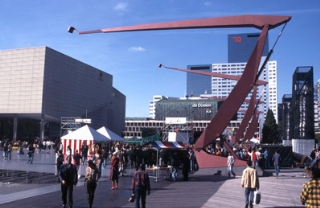


| URL: | http://netzspannung.org/database/124581/de |
| Last update: | 16.02.2004 |
| Date of print: |
 |
Schouwburgplein |
Kurzdarstellung
Kurzbeschreibung
Der Schouwburgplein (12.250 Quadratmeter) liegt im Herzen der Stadt Rotterdam, ist umgeben von Läden und wird vom Theater der Stadt und dem Konzertgebäude der Stadt flankiert. Das Design betont die Wichtigkeit eines leeren Raums, der ein Panorama der City-Skyline öffnet.
Der Platz ist als interaktiver öffentlicher Raum entworfen, flexibel in seiner Verwendung und mit Veränderungen während der Tages- und Jahreszeiten. Sein Erscheinungsbild ist eine Reflektion des Hafens von Rotterdam. Alle erforderlichen Bestandteile waren vorhanden; er musste nur zum Leben erweckt werden. Indem die Fläche des Platzes über die Umgebung herausgehoben wurde, wurde der leere Raum bewahrt und die "City-Bühne" geschaffen.
Eines der Hauptmerkmale des Platzes sind die vier hydraulischen Beleuchtungselemente, die von den Einwohnern der Stadt interaktiv verändert werden können.
KünstlerInnen / AutorInnen
- West8 urban design & landscape architecture b.v.
MitarbeiterInnen
- Adriaan Geuze
- Jerry van Eyck
- Wim Kloosterboer
- Dirry de Bruin
- Cyrus Clark
- Huub Juurlink
- Nigel Sampey
- Erik Overdiep
Entstehung
Niederlande, 1991-1996
Partner / Sponsoren
City of Rotterdam; Duyvis Machinefabriek
(Koog aan de Zaan)
Kommentar
The West8-design of the urban square Schouwburgplein was assigned by the City of Rotterdam.
Eingabe des Beitrags
, 16.02.2004
Kategorie
- kommerzielles Projekt
Schlagworte
- Themen:
- Kulturvermittlung |
- Kommunikation |
- Raum |
- Interaktivität |
- Architektur
- Formate:
- Installation
Ergänzungen zur Schlagwortliste
- Urbanes Design |
- Öffentlichkeit
Inhalt
Inhaltliche Beschreibung
The layout of the square is based on the expected use at different times of the day and its relationship to the sun. These sunlight-zones are reflected in the mosaic of the different materials used on the floor. The west side of the square is a poured epoxy floor containing silver leaves. The east side (with more sunlight) has a wooden bench over the entire length and warm materials including rubber and timber decking on the ground plane. Geraniums are also placed seasonally within this warm zone. Fifteen-meter high ventilation towers from the underground parking are strong vertical elements on the square. Each of these lightweight steel structures is activated with LED displays. Together the three towers form a digital clock. At night, the towers are lit from the inside spreading a soft filtered light. The centre of the square is finished with a deck of perforated metal panels and a wooden play area. The perforated metal panels are lit from below with white, green and black fluorescent tubes. Connections for electricity and water, as well as facilities to build tents and fencing for temporary events, are built into the floor.
Fluorescent lights, form a radiant Milky Way at night. The whole square seems to be floating because of the linear lights that are mounted under the edge of the raised deck. The last major features of the square are the four hydraulic lighting elements. Their configuration can be interactively altered by the inhabitants of the city.
Technik
-
› [0 B
]
[link 02] -
› West8 [JPEG | 140 KB
]
[link 03] -
› West8 [JPEG | 89 KB
]
[link 04] -
› West8 [JPEG | 100 KB
]
[link 05] -
› West8 [JPEG | 97 KB
]
[link 06] -
› Layers (West8) [JPEG | 52 KB
]
[link 07] -
› Lamp Drawing (West8) [JPEG | 44 KB
]
[link 08]
Technische Beschreibung
The red crane-like objects are an integral part of Rotterdam's Schouwburgplein square, which was designed by the Rotterdam urban design office West8. The Duyvis Machinefabriek in Koog aan de Zaan was responsible for the implementation of the West8 design of the cranes into a technical and mechanical device which is now situated in that public place. These hydraulic cranes, which have strong spots attached at their end, are interactive (or at least responsive) and are controlled by a panel situated in the square. Anybody can set the position of the lights individually.
Kontext
Statement
The main goal of the design was making the square more attractive, an attraction in itself even. The program of the buildings surrounding the square are attracting visitors for leisure activities, in daytime and at night. There is of course the biggest cinema of Rotterdam on the square, the main theatre and the concert building; but also restaurants and bars with terraces and shops.
This program needs an attractive space, yet empty enough to be creatively filled in by its users. A stage for the city, that can change its identity like a chameleon changes color. The emptyness also allows one to enjoy the skyline of the city form inside the city. The surrounding buildings seem to form the sidewings of a stage.
The red crane-like objects were designed to enhance the square's attractiveness and this is why they were made interactive. You insert a coin and then they can be moved, together forming a mechanical ballet. (Fanny Smelik)
|
|
| » http://www.west8.nl |
|
|